While ‘food songs’ are not utterly unknown in old Hindi cinema, it’s rather more difficult to track down memorable scenes featuring food. Talk about new cinema, and it’s easier—and when I talk of ‘new’ cinema, I don’t just mean very recent films like Stanley ka Dabba, The Lunchbox, Cheeni Kum, or Chef: I even mean films from the 70s and 80s.
There was Bawarchi, where Rajesh Khanna’s eponymous bawarchi promised Harindranath Chattopadhyay’s character shukto and some three hundred or so types of chutney (he also made kababs out of elephant yams). There was Amitabh Bachchan, surreptitiously stuffing himself on a thali full of puris and other goodies in Do aur Do Paanch, only to be stuffed all over again by a stream of little kids, all instigated by a wily rival (Shashi Kapoor). In Sau Din Saas Ke, Lalita Pawar played an evil mother-in-law, so vicious that she tried to poison her bahu with kheer simmered with gecko.
Pre-70s cinema is a little less easily remembered for its food scenes.
The food songs spring to mind more readily because of the recall value of a song; the scenes are relatively difficult to recall. But here are ten scenes which, to me, showcase food in some way or the other. The love for a particular food, the memories associated with food, the hunger for food, other associations with food. As always, these scenes are all from pre-70s Hindi films that I’ve seen.
1. Mirza Ghalib eats mangoes (Mirza Ghalib, 1954): This, for me, is the most memorable food scene from old Hindi cinema. Firstly, it features mangoes (which also happen to be a weakness of mine, and by far my favourite fruit, as they were for Mirza Ghalib). Secondly, the scene showcases Mirza Ghalib’s love for mangoes, not just through his eager consumption of them (though Bharat Bhushan’s Ghalib is rather more restrained in his savouring of the fruit as compared to his less talkative companions).
That love for mangoes comes through in different ways. Ghalib praises mangoes above sugarcane, because unlike the undiluted sweetness of sugarcane, mangoes offer a contrasting tartness that balances the sweet. He recites a sher in praise of the fruit. And, when an unconvinced companion points to a donkey who’s turned away from a heap of mangoes—the man comments that even a donkey won’t eat mangoes—Ghalib’s dry retort is that yes, it’s donkeys who don’t eat mangoes.
2. Kammo and an ear of corn (Chori Chori, 1956): Food is a time-tested, very powerful holder and carrier and evoker of memories. The flavour of a particular dish can bring back to mind related memories—I, for example, remember eating a particular type of aloo paratha on a long-ago trip through Kumaon, and while I never could find out what masala was used, whenever I encounter that distinct combination of spices again, I am immediately transported back to Almora.
This aspect of food comes through in this scene from Chori Chori, which is actually the second scene in the film that features the humble bhutta, an ear of corn. In the first scene, Nargis’s wealthy and utterly spoilt heiress Kammo turns up her nose at eating something so pedestrian the first time Sagar (Raj Kapoor) offers her bhutta while helping her flee from modern-day bounty hunters. Days later, a changed Kammo—and a grieving Kammo, deeply in love with a man lost to her forever—cannot stomach the rich dishes spread out at the dinner table and asks for roasted bhutta instead. And cries over it as she eats. Or doesn’t eat, really.
3. Ejaz steals halwa-puri (Ghazal, 1964): Food, like everything precious, is all the dearer when it is unattainable. Unattainable for various reasons: mostly, in cinema, because of extreme poverty, but also—as in this case—because of a social norm or restriction that imposes fasting. Sunil Dutt’s Ejaz is a revolutionary poet who scoffs at tradition and mocks strictures. Like the fasts of Ramzan. But openly flouting the roza is too much even for Ejaz, so he sneaks off to the doli/hawadaan when no-one is around, and steals a plate of halwa-puri. He isn’t able to eat much—his younger sister Qauser (Nazima) finds him out and tries to appeal to his better self—but two morsels, big ones at that, are eaten.
4. Preetam sits down to rice and talks of delicacies (Professor, 1962): Food, as in the example from Ghazal, is all the more valued when it is hard to come by—and here, in Professor, the reason for it is more poignant: Preetam (Shammi Kapoor) despite being educated, and despite trying very hard, is still unemployed. His mother (Protima Devi) realizes (like any good Hindi film mum) that his unemployment—and their subsequent poverty—is not his fault, and so tries to hide the truth, that they’re down to their last few grains of rice. That’s all she’s been able to cook, and it’s not even enough for one person, really. When Preetam asks his mother why she isn’t eating, she makes an excuse—the neighbour’s child had his mundan (ritual head-shaving) and she ended up eating so many laddoos, she couldn’t possibly eat any more.
And Preetam, recognizing a white lie when he hears one, counters it with one of his own. Professor Sahib, his former teacher, whom he’s been visiting in an attempt to get a job, fed him really well today. Rasgullas, chamcham, sev-gaathia: he’s so stuffed, he couldn’t possibly eat anything more. So Ma had better share. Sadly, in the ensuing affectionate tussle, Ma’s consumptive cough (which she’s also been hiding from her son) comes on—and it helps give the story the necessary push ahead.
5. Johnny discusses apples while Julie eats biscuits and pakoras (Mr & Mrs 55, 1955): Mr & Mrs 55 was one of those rare films where the secondary pair had a romance with enough cuteness and charm to make for an adorable little film of their own. Johnny (Johnny Walker) is a photographer with a newspaper; a colleague, a ‘steno-typist’ (as they were called) is Julie (Yasmin), whom Johnny falls for the very first time he sees her. And when he happens to run into Julie at a local café (is that an Irani café? Bambaiwallahs, any help?), he sits down and offers to pay for all that she’s eaten and all that she’s going to eat.
Then, while Julie first finishes a biscuit and starts off on a pakora, Johnny starts talking about apples. Kashmir apples, to be precise. Which have dimples on both sides. This man is an accomplished flirt; by the time he’s finished talking, the girl is already smiling, thoroughly charmed.
6. Zamindar Sahib pigs out (Anuradha, 1960): Asit Sen plays a wealthy and gluttonous zamindar in this film: a man so fond of his food that he will not give it up, not for his health. The local doctor, Nirmal (Balraj Sahni) has put Zamindar Sahib on a strict diet, and when this scene opens, it does seem that Zamindar Sahib is sticking conscientiously to it. His guest (Bhudo Advani) is being told how Zamindar Sahib hasn’t eaten even a grain of rice in this last week—and in the middle of this admission, in comes a devoted servant, bearing a platter of samosas, gulabjamuns and imartis. Zamindar Sahib jumps at the goodies, his diet (if it ever was being followed) forgotten. He waxes eloquent about the glory of each of the goodies, he stuffs himself silly—and is interrupted by the arrival of Nirmal himself. Some subterfuge helps at first, but it ends in embarrassment for Zamindar Sahib.
7. Raja tucks into fry dal and more (Patanga, 1949): Raja (Yaqub), a traffic policeman, finds himself suspended after gross inattention on his part results in a bad pile-up. Wandering hungrily through the streets and with no money to buy himself a meal, he finds himself outside a restaurant and sees an interesting (and inspiring) scene. A man (Gope), who’s just eaten a full meal without having a naya paise to pay for it, is thrown out onto the street by the waiters. He can handle being thrown out, decides Raja, as long as he has a full stomach. So he goes in and sets about ordering food. What do they have on the menu? The waiter rattles off a list of vegetables (Raja scoffs at the mention of kaddu—pumpkin—saying that they eat kaddu at home; why would one go to a restaurant to eat kaddu?). He also asks what ‘fry dal’ is, and is very amused to discover that it’s nothing but tali hui dal—the British have gone but they’ve left their language behind, he chuckles.
So he orders three of everything, and tucks in nonchalantly, cribbing about the lack of ghee on the rotis, but finishing off the meal, every last morsel of it. Including the fry dal.
8. Bonding over coffee (Dekh Kabira Roya, 1957): Restaurants appear in Hindi cinema fairly frequently—in various avatars. As part of clubs, with people watching cabaret performances. As shacks. As places where a man takes a woman hoping to impress her. Few eateries, however, play as important a role in a film as the one in Dekh Kabira Roya. This is a plain, no-frills restaurant, but very busy; and this is where the three heroes of the film first meet—a painter, a writer and a singer who quickly become good friends.
From being able to afford only plain water, they progress quickly to coffee—and each man has his own preference: hot coffee, cold coffee, black coffee. Throughout the film, the restaurant becomes their common haunt, and the waiter who always attends to them, played by Sundar, becomes their friend and confidant. So much so that when the respective lady-loves of the three men find themselves in a quandary and reduced to singing ‘sad songs’, this is where they come. They order coffee—black, hot, cold. And listen to the sage advice offered by the waiter, who solves their romantic entanglements. Not much coffee-drinking is actually shown through Dekh Kabira Roya, but the café and its coffee are an integral part of this delightful little comedy.
9. A cake as a lethal weapon (Intaquam, 1969): Cakes are not exactly ubiquitous in Hindi cinema, but if there’s a birthday party anywhere in the story (and not a very ‘Indian’ one, where the sweet is kheer or laddoos) you can pretty much expect cake. Something with lots of icing, ceremoniously cut by a smiling hero or heroine while friends and family gather around and chorus “Happy budday to you!”—and someone proceeds to sing a song, preferably either at a piano or accompanied by someone at a piano. The cake is forgotten.
There are some instances, though, where a cake is important. For me, this somewhat idiotic and convoluted attempt at revenge, using a cake, is memorable simply because of its looniness.
Sadhana’s character, Rita, has wreaked havoc on the plans of a gang of villains, and they decide to have their revenge—not by killing her, as one would have expected for a dastardly lot like this, but by disfiguring her. Rita is going to be cutting a fancy, icing-laden cake at a grand party in the club she owns, and the gang manages to replace it with one of their own—a fake cake, the interior of its lower tier hollowed out so that it can house a balloon filled with acid. The idea being that an unsuspecting Rita, cutting into the cake, will puncture the balloon and the acid will splash up into Rita’s face, ruining it forever. Macabre.
10. Enmity flourishes over balushahi (Ek Hi Raasta, 1956): Barring the instance of the lethal cake in Intaquam, I can’t think of too many other memorable scenes where food and crime are closely linked together. But there’s this scene, in Ek Hi Raasta, where two former crooks meet in a street and end up vowing to have their revenge. Bihari (Jeevan) was once involved in some very corrupt deals along with an accomplice, a truck driver. Thanks to the conscientious whistle-blowing Amar (Sunil Dutt) Bihari and his crony are found out and lose their jobs. Bihari ends up taking to the work of his forefathers: going about with a khomcha, a portable wicker basket-cum-carrying case, selling sweets: balushahi, sohan halwa, motichoor ke laddoo, naankhatai.
One day, wandering about selling his sweets, he meets up with his old accomplice, Pahalwaan, and who should come along but Amar. In the process a fight breaks out, with Pahalwaan and Amar wallowing in the mud and nearly knocking over the khomcha. Not a grand fight, but muddy enough, and what always stands out for me is the mithai-laden khomcha.
So that’s my list. Ten food scenes, not necessarily very good scenes, but memorable scenes. I didn’t have to go trawling through old films to look for these scenes: these scenes popped up by themselves in my mind. How many others can you add to the list?


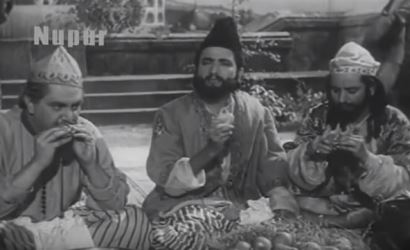
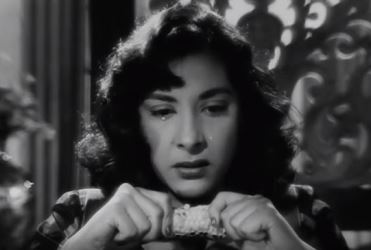
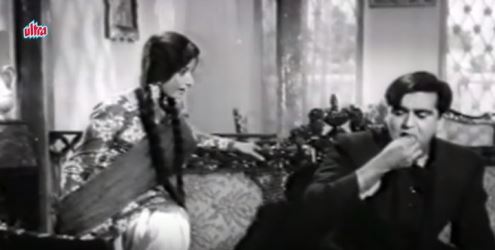
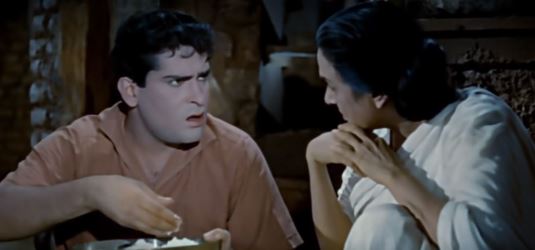
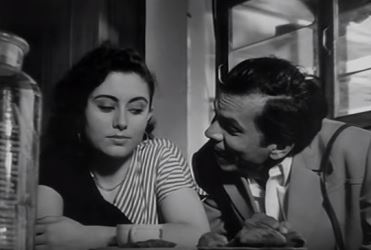
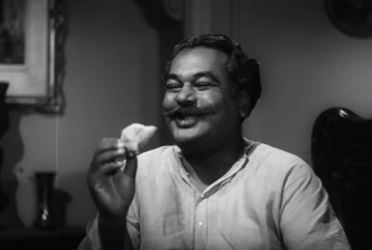
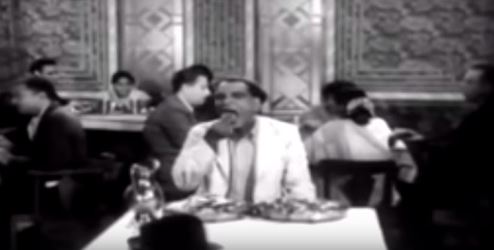

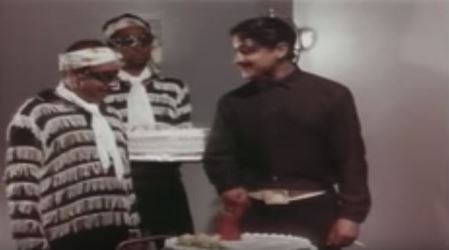
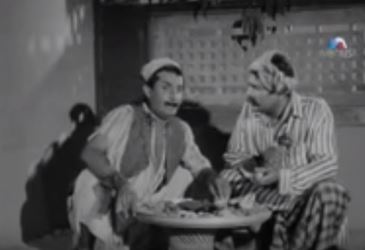
Is it possible to do a piece on Bollywood’s musleman. Not just Dara Singh but the lesser lights like Saudagar Singh, Zbisko, Shetty et al.
LikeLike
Not me. I am not interested in that at all.
LikeLike
Wow
It is a wonderful post, and a collection of such scenes is such a hectic task. Hats off to your memory.
The post is icing on the cake. So far I enjoyed all the posts, but this became my favorite. It’s just wonderful. I’m short of prasing words.
Too good
Too good
Right now, I remember only two scenes
One from Khiladi, starring akshay kumar. The college canteen scenes, there are a few I guess!
With Guddi Maruti eating voraciously.
Second from Bride and prejudice
Mr kohli having lunch with the anupam kher’s family.
I’ll see whether I can get videos
Yes here’s the one from Bride and prejudice
LikeLike
They are eating a lot of food in the Bride and Prejudice scene, but what is it? Is there any mention? Do they talk about food? I had a quick look but couldn’t tell (and don’t recall).
Thank you for the appreciation. I’m so glad you enjoyed this post. :-)
LikeLike
Oh
I forgot completely the criteria..
In this scene, food is just there.
Oh
My ignorant behavior
LikeLike
No problem. :-)
LikeLike
Oh my God
I found the second scene as well, I wasn’t expecting
LikeLike
I don’t recall having seen this one before. But it reminded me of something I had thought of posting: one of the many cake fights we see in old Hindi cinema. Lots of cream flying, free-for-all stuff. But there are too many of those to pinpoint one is being particularly memorable.
LikeLike
Hi
One more from andaz apna apna
LikeLike
Wah! This one really meets the brief. :-D I need to rewatch this movie. It’s been so long!
LikeLike
it’s such a great fun to watch this movie
It’s really a classic
I enjoy it every time I watch it.
:-)
LikeLike
Yes, it’s hilarious. I’ve never liked Salman Khan, but this is the one film where I even like him.
LikeLike
Hi Madhu, I was waiting for a food post on Hindi movies and this was wonderful. Thank you :)…..Some scenes came in my mind instantly. Do not remember all the details but here they are.
1. Gumnaam, 1965. Not necessarily eating but Mehmood literally damages (butchers) the food in the aftermath of the “Hum kale hain to” song and slyly wonders what will he feed the (surviving?) members. Also worth to notice the mysterious villain had ensured adequate food along with a cow for milk requirements on the island! Atleast this ensured the members were well fed before meeting their fate!!!
2. Taj Mahal, 1963. Bina Rai “rescues” Pradeep Kumar by distracting the palace guards by I guess some drug laced sweets probably laddoos. I think a similar plot was followed in Raja aur Rank.
3. Ashirwaad, 1968. Jogi Thakur Ashok Kumar eats at Harindranath Chattopadhyay’s house establishing he treats all human beings as one and not discriminate on basis of birth, caste, religion etc
4. Mere Humdum Mere Dost, 1968. The one scene I found hilarious, Dharmendra arrives for dinner at Sharmila’s house with a cat. Then tries to “cut” a chicken which “flies” off in to another guest’s plate and so on visibly embarrassing his rich fiancee.
5. Junglee, 1961. I recall that scene where Shammi Kapoor gathers his office staff for lunch and discovers the meagre (empty??) tiffin of a female staff. Very poignant reaction from Shammi.
LikeLike
Thank you! I did do a post on food songs, but I guess if you’re not really into film music, that wouldn’t have appealed to you. Glad you liked this one. :-)
I had forgotten all about the scenes you mention (except Gumnaam) – although, barring the Aashirvaad one, I remembered all of them by your descrption, Especially that chicken flying out of Dharmendra’s plate. Hilarious! Gumnaam I had considered for the first scene where they eat in the island mansion – each of them demands something different, and Mehmood is grumbling about how one wants this and one wants that. Nanda even goes into the kitchen to help him and comes out with a plateful of kebabs.
Thanks for the scenes you mentioned! Exactly the sort of stuff I had in mind.
LikeLike
My apologies. I am very much into film music and had shared my two cents contribution in that post as well. I was waiting for a post on food “scenes” as these are many in number compared to food songs. So this list fulfilled my wish! Thanks again!!!!
Regards..GG
LikeLike
No worries. :-)
LikeLike
One more from RHTDM
R madhavan eating non-vegetarian food
And
A similar scene from Ajab Prem ki gazab kahani
And one more food scene from Rab ne bana di Jodi
LikeLike
I’ve seen neither Rehna Hai Tere Dil Mein nor Ajab Prem ki Gazab Kahani, so didn’t know about those two scenes! But the golgappa scene (followed by the biryani scene) in Rab Ne Bana Di Jodi was on my mind when I wrote this post – I was hoping someone would mention it! Thanks for those.
LikeLike
LikeLike
It’s been a long time since I watched Aadmi aur Insaan, and I’d completely forgotten about this ‘mithai shopping scene! Thanks for this.
LikeLike
The restaurant scene from Ram Aur Shyam.
Shyam does a slick ‘dine and dash’ and Ram is stuck with the bill. Pretty cool acting by Dilip Kumar I thought.
LikeLike
It’s been a long time since I watched this film – I’d forgotten this scene! Delightful one, thank you.
LikeLike
I was about to post this scene, but through quick scan of posts, found its already posted by you. Thanks
LikeLike
:-)
LikeLike
This scene with Mehmood in Main Sundar Hoon:
LikeLike
Another one I’ve forgotten. :-( Though, in this case, it’s a movie I don’t even want to revisit. Somehow Main Sundar Hoon didn’t appeal to me at all.
LikeLike
Thanks for the list!! There is another hilarious scene from Ram aur Shyam in Waheeda’s home – Dilip Kumar literally attacking the breakfast! Loved the “something something – dekh Kabeera roya”
LikeLike
Oh, nice, Nishi! I’d forgotten this one too. High time I rewatched this film. :-)
LikeLike
Madhu ji , hats off to U !!!
A full month dedicated to a very very rare subject , rather no one could ever think of writing such a theme.
This is going to be a gr8 piece of documentation of such kind.
I think U r able to do this gr8 work as U r blessed by मा सरस्वती and मा अन्नपूर्णा .
Though as a reader , I am proud to be a part of this blog.
LikeLike
Thank you, Pramodji. I’m so glad you enjoyed this month of food and movies.:-)
LikeLike
I have nite yet figured out how to take scene-grabs from youtube so can’t share very accurate scenes, but let me try :
Apne Paraye was a delightful move, with a lot of kitchen politics! (literally). It has a lot of scenes in the kitchen involving cooking and eating, and then also the traditional format of the menfolk eating and being attended to…very traditional, very tempting.. because I forever imagine a full course Bengali meal being served.
The following medley of clips doesn’t list a lot of scenes I have in mind, but gives a flavour of some..
Golmaal was another Utpal Dutta movie with this delightful scene of Amor Paleker being discovered for his charade while he is eating Aloo ke Paraanthe and of course just a moment later is promised to be fed Mooli ke Paraanthe as well by Buaji (Shubha Khote). Also all the descriptions of Kalkatte ka Rajbhog, Mathura ka Petha..and so on and so forth
Another lovely comedy, Angoor , has this episode of Bhaang laced Pakode, which is hilarious and of course very very tempting ..(the Pakodas and the movie both !!)
LikeLike
Ooh, yes! The bhaang-waale pakode! Just the memory of that scene always cracks me up. I’d forgotten the aloo paratha scene from Golmaal, and you have just reminded me that Apne Paraye is a film I need to watch, sooner rather than later. Thank you for these, ak. Great examples.
LikeLike
Another clip of the same ..Pakode and Angoor…
LikeLike
Hehe. So good. I’d forgotten this bit.
LikeLike
A most wonderful month. But no heroes favourite aloo ka paratha or gajar ka halwa scene.
Right now I have just one scene to add. This one’s from the devotional movie Hari Darshan (1972). You see I saw it a long time back and this particular one (other than beheading of Prahlad’s mother Kayadhu) remained in memory. Prahlad and few others chanting Lord Vishnu’s name have been imprisoned by Hiranyakashyapu and he has ordered to starve them as a punishment. But then Goddess Lakshmi comes to the rescue by using a lot of special effects as all the food gets prepared automatically. I don’t have the particular scene but am giving the link for the movie. Just check out around 2hrs and 20 minutes into the movie:
LikeLike
Wow. This is so cool! Thank you (I kept wishing, as I was watching that scene, that something like that would happen in my home occasionally – it would be fun to not have to cook! And to still get all these delicious-looking things served up).
LikeLike
Here’s the Bombay to Goa scene
LikeLike
Oh, yes! I’d forgotten this, even though I watched Bombay to Goa only a few years back. But just seeing that boy’s face at the start of the clip reminded me.
LikeLike
I come late to this post and most of the scenes I want to add have already been mentioned! :( Never mind, this was such an interesting post.
I wonder whether this would count?
In Jab Pyar Kisise Hota Hai, there’s a scene before Ye aanhen uff yumma where a truck driver offers the lead pair some bhang-laced laddoos. The pair eat them, and while Dev Anand realises soon enough that they are doctored, he still continues to chew them meditatively.
You mentioned Cheeni Kum and I was reminded of this scene:
Or this one from Hum Dil De Chuke Sanam
A hilarious scene from Three Idiots. :)
Chashme Buddoor had the famous tutti-frutti scene, remember? :)
From around 5.08 minutes in.
LikeLike
I’d forgotten the 3 Idiots scene completely and the others had partially slipped my mind, but your mention of them reminded me. That tutti-frutti scene is a delight, and yes, I certainly think the laddoo scene from Jab Pyaar Kisise Hota Hai fits. Another example of food used in a crime!
LikeLike
What a fun post. Complements your series on international cinema so well. The one I remembered upon reading your post was Choti si Baat and the scene in the famous Samovar restaurant. While I couldn’t find the clip online, here’s a detailed post of what was ordered: https://chickenalapoos.com/2016/04/11/lunch-at-jehangir-art-gallery/
LikeLike
Thank you, Amrita – for the appreciation, of course, but also for that very valuable addition. Now that’s the sort of emphasis on food that I was looking for. :-) I watched this movie eons ago and had forgotten pretty much everything about it.
LikeLike
Thank you. Glad to jog your memory about this gem of a movie.
LikeLike
:-)
LikeLike
There’s this song sequence from Khandan (1942)… What a wonderful party this is! But one thing that has always stood out for me was the uncovering of the food (which happens in this particular video at about 1:33). No, I just haven’t seen a whole lot of food and eating in very old Hindi song scenes, and this food looks delicious!
And if I may move on to a different language, there’s the scene for the song “O re Halla Rajar Sena,” in which bowls of sweets fall from the sky, in Satyajit Ray’s 1969 film, Gupi Gayen Bagha Bayen:
LikeLike
That Goopy Gyne Bagha Byne scene is such a brilliant fit for this post! Thank you for that one especially, Richard! Superb.
LikeLike
Madhu, I’m glad to see that you liked that one so much, and thanks for the nice words!
LikeLike
:-)
LikeLike
All I can think of is this rather silly scene from Half Ticket. Kishore was peerless as a singer, an actor of rare talent. More often than not his talents would be wasted, particularly his comedic outings which would rapidly devolve into hamming. This is a prime example:
LikeLike
I’d forgotten about this one – possibly because Half Ticket is one of those Kishore Kumar outings I cringe from rewatching! I agree with you about him being ‘an actor of rare talent’. I wish more people had recognized that talent and used it; it’s a pity that it got wasted in so much embarrassingly hammy roles.
LikeLike
Re: Intaquam, an acid filled balloon hidden in a cake is horrid… But it reminded me of a food-related film I’d forgotten about…Birthday Blues(1932) a Hal Roach Our Gang/ Little Rascals short subject, Dickie Moore wants to raise money to buy his mother a dress, so he and his friends decide to make a cake with prizes baked inside (whistles, toys etc.) and sell pieces of it. During the mixing of it some other objects get into it, and the cake itself in unforgettable, a giant bulging cube…On youtube there is a 5 minute video of the highlights posted by wbgo listed as Perfect Sound Effect: Little Rascals Exploding Cake
LikeLike
Yes, that acid-filled balloon was horrid, but the tacky way in which the entire situation was set up somewhat deflated the horridness of it all…
Thank you for telling me about the scene from Birthday Blues! That is a very memorable scene indeed. I doubt I’m going to forget it in a hurry.
LikeLike
As is obvious I am now seldom online. I have been meaning to go through all your food and movie related posts, but I just did not get the time. Right now I am delaying lunch to post this comment. I will be honest I have just scanned through this post, I will read this and your other food related posts later, but first just let me share something interesting, you see as a kid I was a very fussy eater and therefore very thin. Food other than non-veg food did not interest me at all, as I grew up I slowly started eating and experimenting with food much to my mom’s relief. Besides that, I developed an interest in some dishes only after seeing actors relishing these dishes in some films. Now whether they were just acting or really relishing them is debatable, actors are sometimes compelled to spit out the food soon after the director calls ‘cut’, because the food they apparently relish on screen is almost inedible.
LikeLike
That’s an amazing bit of trivia, Shilpi! I hadn’t realized that was the case. I guessed, of course, that it would be impossible for actors to go on really relishing whatever they were supposed to be eating onscreen, but that it would be almost inedible – I hadn’t known that. This reminds me of an anecdote I remember reading about some actor – I think a Hollywood star, though I don’t remember who – who was being praised by someone for portraying a drunk very well. For some movie in which this actor was constantly to be seen with a glass of whisky. The actor had to explain to his admirer that it was apple juice, because if he actually drank that much whisky, he’d never remember his lines, let alone act.
LikeLike
Back in the day when we were kids, there was Coca Cola the only Cola that was available in India. Then Coca Cola left and then came Thumsup and other Indian Cola brands, then again the economy opened up and back came the global bands, the reason I am giving you this lesson on this subject of Cola brands is to tell you that back when we were kids it was just Coca Cola that was available in the country. This was mixed with water to replace the real hard drinks for films. It looked pretty much like whisky. Maybe you know this but even so I am sharing this bit of info, for ice cream ads usually boiled and mashed potatoes are used. You see the real ice cream will melt thanks to the heat generated by studio lights. Often food stylists use colour and other ingredients that are not of food grade. The chicken that looks appetizing on screen or the press ad may not even be fully cooked. The idea being as long as it looks good on camera then it is okay . Interestingly once a chayvanprash (hope I got the spelling right) brand used grease instead of the real thing because that looked better on camera than the real chayvanprash. On the other hand I was once informed by the creative director of an ad agency ( I was doing a behind the scenes story on their ad) that they had used mayonnaise to show molten steel. Of course the mayonnaise was worked upon post production to get the look of molten steel.
LikeLike
Shilpi, what a brilliantly informative and entertaining comment! I knew some of that – the mashed potatoes for the ice cream, for example, and the fact that a lot of things aren’t cooked all the way through just so that they look more appetizing – but the Chyawanprash/grease one and the mayo/molten steel one was new to me. Delightful! I remember my niece telling me about one photo shoot where, to simulate steam rising from newly cooked food, a photographer’s assistant knelt beneath the table and blew out a puff of smoke from a cigarette just at the right time. :-)
LikeLike
It’s said that Frank Sinatra, ( for numerous reasons) “disliked” Marlon Brando during the filming of ‘Guys and Dolls’, one being Sinatra liked to get his scenes right on the first take…One scene required him to be eating cheesecake while Brando was talking, and Brando kept messing up his lines, after eight attempts Sinatra is said to have jabbed his fork into the table and yelled “How much cheesecake do you think I can eat!!!” Expletive deleted…
LikeLike
That’s a hilarious anecdote! It’s been several years since I watched Guys and Dolls, so I’ve forgotten that, but I’m tempted to go watch it again.
I am intrigued, though, by some actors who end up in foodie films and are otherwise probably very particular about their diets. For instance, Brad Pitt’s character in Ocean’s Eleven (and its sequels) is almost always seen eating or drinking something – and no, nothing healthy, either. And I watched a South Korean drama series called Let’s Eat in which the main cast pretty much ate their way through every single episode – considering Korea’s obsession with slimness and beauty, that interested me, because I couldn’t really imagine those actors really eating all that stuff.
LikeLike
This is such a wonderful read! Really delightful. As my mum-in-law tells me, you can expect two things in a Bengali film: food and alna. Not sure about the latter but I remember the scenes that involved food in Sahib, Bibi aur Ghulam and of course Golmaal (Utpal Dutt eating laddoos and also watching Amol Palekar eat parathas) and Chupke Chupke (Dharmendra eats way too much post marriage, he also has to fetch breakfast for the students – anda, bread, chai, makkhan aur mai – and after Amitabh leaves Asrani’s house the cook asks if he should cook baigan ka bharta and the response he receives “Is ghar mein baingan ka bharta kabhi nahin banega!”).
One of my favourites is from Tum Haseen Main Jawaan where Dharmendra’s date is ruined by Johnny Walker and Hema Malini. But before that can happen, his date asks him, “Tumhe taange pasand hain, ya seena?” Dharmendra responds with his typical, “Jee?”
“Mujhe to chicken ka seena bahut pasand hain,” she says and the conversation continues.
LikeLike
That Tum Haseen Main Jawaan scene, I’d forgotten! That sounds so hilarious. :-D I mus go back to the film and check it out, I can just imagine Dharmendra saying that.
I agree about Bengali directors being pretty good at bringing food into their movies. The examples of cited are delightful ones, and there are a few scenes even in the scenes I’ve listed (Anuradha, for one) which are by Bengali directors.
LikeLike
I haven’t watched Anuradha, but the scene described sounds delightful.
Bengalis and food, in general, is too vast a topic to comment on :) Which reminds me…Amar Prem and kachoris, and also Anand Babu pining for homemade luchis and sabzi. The title of the story on which the film is based is Hinger Kochuri, I think. And who can forget Waheeda Rehman offering to pay for Guru Dutt’s meal in Pyaasa?
Adore the Rab ne Banadi jodi scene… :)
Do you remember the scene in Seeta aur Geeta? Manorma has been pushed into the kitchen and is chopping vegetables. Satyan Kapur says something along the lines of “Kuch jalne ki boo aa rahi hain” and she widens her eyes and says, “Yahaan mera dil jal raha hain,” He responds, “Achcha, toh aaj khaane mein non-veg ban raha hain.” Manorma was so much fun!
LikeLike
“Bengalis and food, in general, is too vast a topic to comment on :) ”
So true! I think it was in Madhur Jaffrey’s A Taste of India that I read about a Bengali insisting that there were only three great cuisines in the world: French, Chinese, and Bengali! :-)
Talking of Bengali film makers and food, Bawarchi also comes to mind, with Rajesh Khanna’s character promising shukto and some 300 types of chutney to Harindranath Chattopadhyay. Plus, making elephant yam kababs.
I’d completely forgotten the Seeta aur Geeta scene! Yes, delightful one. Hema Malini is a hoot in that film.
LikeLike